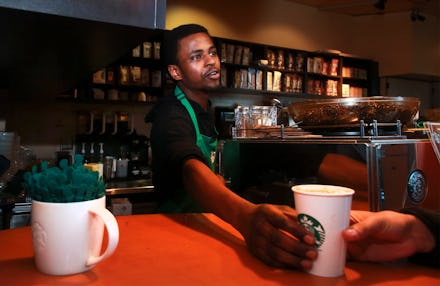There's One Problem with Starbucks' New Anti-Racism Campaign

Starbucks wants you to know it cares about racial inequality. It cares so much that it's asking its "partners" — employees, to the layperson — to write the words "Race Together" in Sharpie™ on everything you buy to get you to talk about racial equality with your friends this week.
This is a good thing. Honest dialogue is sorely missing from Americans' conversations about race, and we all could use a reminder that we're not as "post-racial" as we'd like to believe. There's just one problem — and that problem has a lot to do with Starbucks itself.
Since at least 1997, Starbucks has played an instrumental role in the gentrification of America's cities. A recent survey of real estate database Zillow, published at Quartz, confirms that homes within a quarter mile of a new Starbucks location appreciated in value 31% faster than the average American home between 1997 and 2014.
The report claims this connection is causal. Housing near Starbucks appreciates less the further it is from the store, while competing coffee sellers, like Dunkin' Donuts, do not see a similar impact on their surroundings. Critics have since pegged Starbucks as synonymous with rising home costs. If you see one popping up in your neighborhood, expect a bump in your rent to come with it.
Gentrification has been a hotly contested issue for decades. It's a hard phenomenon to measure, but as Mic has written, most agree that "its harbingers include the rapid influx of young, well-to-do white people into once low-income neighborhoods." This demographic shift comes with landscape shifts as well — more organic grocery stores, yoga studios and, of course, coffee shops.
It also means poor and working-class people get priced out of their homes and are forced to move elsewhere. This often occurs along racial lines. And people of color get the short end of the stick.
Consider this: Aside from Boston, which is 50% white, the seven fastest gentrifying cities in America have faced some of their starkest home appreciation since 2000 in low-income neighborhoods of color. Racial segregation and discriminatory housing policies in the 20th century mean a city's poorest areas are often those with the highest concentration of racial minorities, making gentrification a de facto race issue in most of these cases. People who can no longer afford the soaring rents are priced out, and entire local cultures and histories relocate or disappear.
This is no accident. It's also no accident that those hit hardest by fast-appreciating homes are those same, poor people of color.
But is Starbucks completely to blame? It's up for debate, the Guardian says. Some of these housing prices appear to have been rising anyway — albeit not as quickly — while the closure of 600 Starbucks locations in mostly low-income neighborhoods in 2008 suggests the chain had trouble gentrifying neighborhoods single-handedly, especially during the Recession. Either way, the rise in home costs combined with the already pervasive perception of Starbucks as a major gentrifier speaks volumes. Its presence definitely seems to fuel the phenomenon, and undeniably profits from it.
Which brings us back to "Race Together." It's clear that not even Starbucks, a multibillion-dollar behemoth with 21,000 locations in 65 different countries, thinks it can solve America's race problem with a full-page ad in the New York Times and a hashtag. That was never the goal. According to company spokesperson Linda Mills, the campaign was designed merely to promote dialogue, share ideas and determine the company's role in addressing this issue moving forward.
What this actually means is unclear, even to the people at Starbucks.
"Right now, we're just soliciting information and working on understanding the landscape better," Mills told Mic, when asked about the company's role in fueling gentrification. So far, CEO Howard Schultz has hosted a number of town hall-style meetings in multiple cities — Oakland, Los Angeles, St. Louis, New York City and Chicago — where employees have aired their feelings and experiences around race in their daily lives.
But besides that, a catchphrase on a coffee cup and a planned op-ed in partnership with USA Today (to be published this Friday), "Race Together" has no concrete plans for addressing racial inequality. It's a fair position, even a laudable first step considering most corporations' silence around the subject. But as long as the company is negatively, even if unintentionally, impacting people of color, "Race Together" rings hollow.
To avoid becoming a superficial and hypocritical PR campaign piggybacking on a hot-button political issue, Starbucks needs to address racial inequality in the cities it's helped gentrify. These communities are the clear place to start. And not just whether the company can do anything to alleviate gentrification's impact, but when, where and how it will do so.